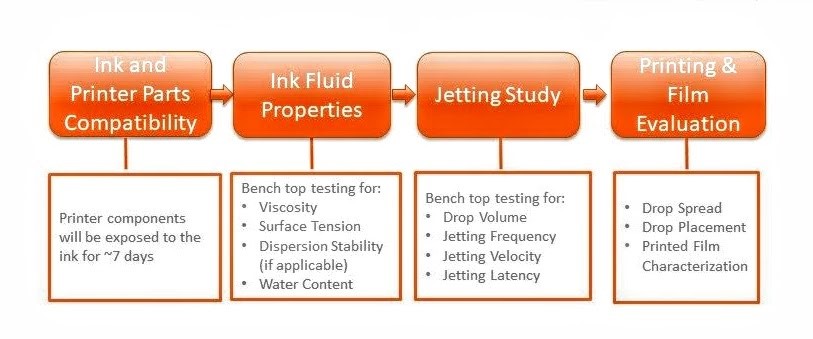When an inkjet printer is engineered from the ground up to mass produce next generation displays, ink is integral to the product development strategy. And although inkjet is now a mainstream manufacturing technology for OLED thin film encapsulation (TFE), newer applications like OLED RGB and Quantum Dot Color Filter (QDCF) are creating new performance imperatives for inks.
Pairing inks with the inkjet printer is no simple task. The chemical structure-property material design must meet inkjet printing imperatives. Also, inks must meet hardware, process and device integration requirements for the targeted display application.
Printer, Meet Ink.
Kateeva’s YIELDjet inkjet printer is built to process any type of substrate – rigid or flexible, glass or plastic, and inks from any vendor. Optimizing ink performance is integral to the system’s capabilities. For instance, if an ink with good jettability has poor spread, surface treatments can be applied to improve the substrate-ink interaction (Fig. 1). If an ink shows excellent on-device performance but has poor jettability, the ink formulation can be improved by modifying the chemical structure and fluid properties that influence rheological and surface tension forces, as well as dispersion matrix or surface chemistry of the functional compound.

Fig. 1: Effect of UVO treatment to modify substrate surface for better TFE film formation
Take high light extraction inks for TFE, for example. These specialized inks were developed to minimize light losses caused by total internal reflection due to large differences in refractive indices at film interfaces in a device stack. Some inks make use of optically transparent nanocrystals with high refractive indices dispersed in a UV curable matrix. These nanoparticle inks need to be surface-modified with appropriate capping ligands to minimize particle-to-particle interactions for good inkjet printing and film performance. In addition, when designing ink formulations, proper selection of functional components, dispersant (on the surface of the functional molecules) and corresponding matrix is necessary to minimize agglomeration. Also, the ink must be compatible with printer components to ensure a robust process for mass manufacturing.
Getting the Recipe Right
When customers request a new ink qualification, Kateeva’s chemistry experts deploy a rigorous test plan where every single step is targeted to validate the ink’s fluid and film formation properties (Fig. 2).
In the initial phase of the test plan, a compatibility test exposes various printer components to the ink for seven days. Once the ink is determined to be compatible with the printer components, benchtop tests are performed to map out the ink’s fluid, jetting and dispersion (if applicable) properties, before introducing into the inkjet printer to characterize printed film properties.

Fig.2: Process flow for new ink qualification
Some inks are more challenging to formulate than others. That’s where Kateeva’s chemistry experts intersect with our printer, print-head and software experts. The team collaborates to ensure that our high-performing inkjet printers are compatible with a broad array of solvent, monomer and polymer-based inks.
Ink readiness is not a simple feat. That’s why Kateeva offers a comprehensive solution for inkjet printing. Over the years, we have completed countless ink qualifications, enabling customers to achieve excellent print and device performance for a variety of OLED-related applications.
YIELDjet is a trademark of Kateeva, Inc.
 简体中文
简体中文 한국어
한국어 English
English
